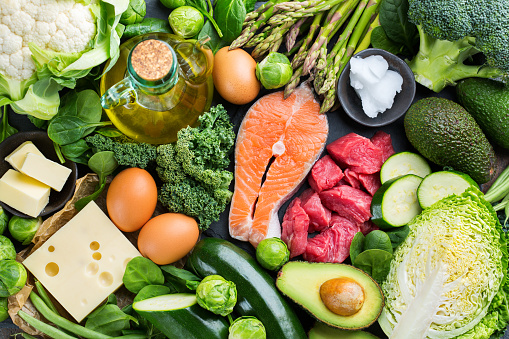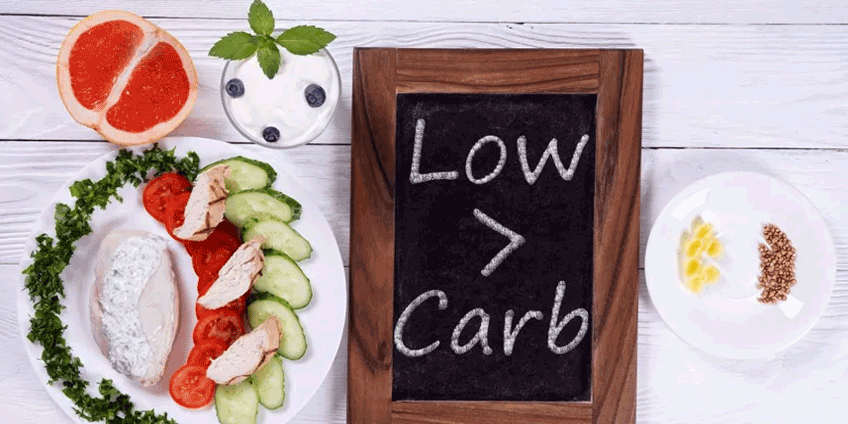A low-carb diet could be the answer for you! It is an efficient method for losing weight and increasing energy levels.
In this blog, we will present a beginner’s guide to getting started on a low-carb diet.
What is a low-carb diet?
Carbohydrates are a macronutrient that gives energy to the body. They are an important part of a balanced diet when consumed in moderation. They can, however, contribute to weight gain and metabolic issues when ingested in excess.
A low-carb diet reduces carbohydrate intake while increasing protein, healthy fats, and non-starchy veggies.
Individuals can lose weight while improving blood sugar regulation and reducing cravings for sweet meals by reducing carb intake and forcing the body to utilise stored fat as fuel.
The ketogenic diet and Atkins diet are two well-known examples of low-carb diets.
Know more about No-Sugar Diet!!!
Benefits of a low-carb diet
A low-carb diet is a type of diet that limits the intake of carbohydrates, including sugar, bread, pasta, and rice, and encourages the consumption of protein, healthy fats, and non-starchy vegetables. Here are some of the potential benefits of following a low-carb diet:
- Weight loss: A low-carb diet can lead to weight loss because it reduces the amount of insulin produced by the body, which in turn reduces hunger and promotes fat burning.
- Improved blood sugar control: A low-carb diet can help lower blood sugar levels, which is particularly beneficial for people with type 2 diabetes or insulin resistance.
- Reduced risk of heart disease: A low-carb diet can lead to improvements in cholesterol levels, blood pressure, and other risk factors for heart disease.
- Improved brain function: Some studies suggest that a low-carb diet may improve cognitive function and reduce the risk of neurological diseases like Alzheimer’s.
- Better digestion: A low-carb diet can help improve digestive health by reducing the intake of processed foods and increasing the consumption of fiber-rich vegetables.
- Reduced inflammation: A low-carb diet can help reduce inflammation in the body, which is linked to a variety of chronic diseases.
It’s worth noting that the benefits of a low-carb diet may vary depending on individual factors, such as age, gender, activity level, and health status. As with any diet, it’s important to consult a healthcare professional before making any significant changes to your eating habits.

Getting Started with Low-Carb Diet
Beginning a low-carb diet can be intimidating, but it does not have to be.
- You may set yourself up for success by learning the fundamentals and planning ahead of time.
- Meal planning is one of the most important components of any diet.
- Focus on full, unprocessed foods like meat, fish, eggs, vegetables, nuts, and seeds while beginning a low-carb diet.
- Incorporating healthy fats and proteins into your diet will keep you satisfied and energised throughout the day.
- Keeping track of your progress by tracking your weight loss and energy levels will also help you stay motivated and on pace to reach your goals.
For the greatest results, always consult with a healthcare expert before beginning any new diet or exercise routine.
How to plan a low-carb diet?
Planning a low-carb diet involves making dietary changes that prioritize protein and healthy fats while reducing the intake of carbohydrates. Here are some general steps to help you plan a low-carb diet:
- Determine your daily caloric needs: Use an online calculator to determine your daily caloric needs based on your age, sex, weight, height, and activity level. This will help you determine how many calories you need to consume each day to maintain your weight.
- Set a carb goal: Determine how many carbs you want to consume per day. Generally, a low-carb diet limits carbs to 50-150 grams per day, depending on your individual needs and goals.
- Choose high-protein foods: Include lean proteins such as chicken, fish, turkey, tofu, and eggs in your meals. These foods can help you feel fuller longer and reduce cravings.
- Incorporate healthy fats: Choose healthy fats such as olive oil, avocado, nuts, and seeds to help you feel fuller and provide essential nutrients.
- Choose low-carb vegetables: Include low-carb vegetables such as spinach, broccoli, cauliflower, kale, and zucchini in your meals. These vegetables are high in fiber, vitamins, and minerals and can help you feel full.
- Reduce processed foods and added sugars: Avoid processed foods and added sugars, which are often high in carbohydrates and can lead to weight gain and other health problems.
- Plan your meals: Plan your meals in advance to ensure you are meeting your carb goals and getting the necessary nutrients. This can help you stay on track and avoid unhealthy foods.
Remember, before starting any new diet or making significant changes to your eating habits, it’s always a good idea to consult with a healthcare professional or a registered dietitian to ensure you’re making healthy choices that are appropriate for your individual needs and goals.
How to calculate your carb intake?
To successfully start a low-carb diet, it’s essential to calculate your daily carb intake. This allows you to adjust your carbohydrate intake based on individual needs and goals.
- To do this, you need to determine your daily caloric needs and then adjust your carbohydrate intake accordingly.
- Most low-carb diets recommend limiting carbs to 20-50 grams per day, depending on individual needs and goals.
- Remember to choose healthy, whole-food sources of carbohydrates like vegetables, fruits, and whole grains for a balanced diet.
Tracking your carb intake using a food diary or app can help you stay on track and reach your weight loss and energy goals.

Foods to eat on a low-carb diet
A low-carb diet typically involves reducing or limiting your intake of carbohydrates, including foods like bread, pasta, rice, and sugary drinks. Here are some foods that are suitable for a low-carb diet:
- Meat: Beef, chicken, pork, lamb, and other meats are great sources of protein and are low in carbs.
- Fish and seafood: Salmon, tuna, trout, shrimp, and other fish and seafood are also low in carbs and high in protein.
- Eggs: Eggs are a versatile and low-carb food, and they can be cooked in many different ways.
- Vegetables: Leafy greens, broccoli, cauliflower, zucchini, and other non-starchy vegetables are low in carbs and high in fiber.
- Nuts and seeds: Almonds, walnuts, chia seeds, flaxseeds, and other nuts and seeds are low in carbs and high in healthy fats.
- Dairy products: Cheese, yogurt, and other dairy products are low in carbs and high in protein and calcium.
- Berries: Strawberries, raspberries, blueberries, and other berries are low in carbs and high in fiber and antioxidants.
It’s important to note that while some fruits and vegetables are low in carbs, others are higher in carbs and should be limited or avoided on a low-carb diet. It’s also important to focus on whole, unprocessed foods and to stay within your daily calorie needs to achieve your weight loss or health goals.
Foods to avoid on a low-carb diet
If you’re following a low-carb diet, you’ll want to avoid foods that are high in carbohydrates, particularly refined and processed carbs. Here are some common foods to avoid on a low-carb diet:
1. Sugar and sugary foods: This includes soda, candy, cakes, and other sweets.
2. Grains and grain-based foods: Avoid bread, pasta, rice, and cereal.
3. Starchy vegetables: This includes potatoes, sweet potatoes, and corn.
4. Fruit: While some fruits are low in carbohydrates, many are high in sugar, so it’s best to limit or avoid them.
5. Legumes: This includes beans, lentils, and chickpeas, which are high in carbohydrates.
6. Processed foods: Many processed foods are high in carbohydrates, so it’s best to avoid them as much as possible.
7. High-carb condiments: This includes ketchup, honey mustard, and barbecue sauce, which are often high in sugar.
Instead of these foods, focus on eating whole, nutrient-dense foods like meats, fish, eggs, non-starchy vegetables, nuts, and seeds.
Meal Prepping for a low-carb diet
Meal prepping for a low-carb diet can be a great way to stay on track with your nutrition goals and make healthy eating more convenient. Here are some tips for meal prepping for a low-carb diet:
1. Plan your meals: Take some time to plan out your meals for the week ahead. Choose recipes that are low in carbohydrates and high in protein and healthy fats. This will help you to avoid reaching for high-carb snacks or meals when you’re hungry.
2. Shop for groceries: Once you have your meal plan, make a list of the ingredients you’ll need and go grocery shopping. Stick to the perimeter of the store where you’ll find fresh produce, meat, and dairy products.
3. Prepare ingredients: Once you have your groceries, it’s time to prepare your ingredients. Chop vegetables, cook meat, and portion out any snacks or sides that you’ll be including in your meals.
4. Use portion control: When you’re portioning out your meals, make sure to use appropriate portion sizes. This will help you to control your calorie intake and ensure that you’re getting the right balance of macronutrients.
5. Invest in quality storage containers: Good storage containers will help to keep your food fresh and prevent it from spoiling. Look for containers that are leak-proof, microwave-safe, and easy to clean.
6. Freeze meals for later: If you don’t think you’ll be able to eat all of your meals within a few days, consider freezing them for later. This will help to prevent food waste and give you some healthy options for days when you’re short on time.
Some low-carb meal prep ideas include:
- Grilled chicken or fish with roasted vegetables
- Cauliflower rice stir-fry with shrimp or tofu
- Turkey or beef chili with mixed greens or a side salad
- Hard-boiled eggs with sliced vegetables and hummus
- Vegetable frittata or quiche with a side of mixed berries
- Tuna or chicken salad with lettuce wraps or celery sticks

How does a low-carb diet assist with weight loss?
One of the most efficient ways to reduce weight is to limit your carbohydrate intake. A low-carb diet can help you lose weight by lowering your overall calorie intake.
Cutting carbs lowers insulin levels, allowing your body to burn stored fat for energy instead of glucose. Furthermore, low-carb diets are more satisfying, requiring you to consume less calories overall.
Low-carb diets have been shown in studies to result in higher weight reduction than low-fat diets, but it is critical to speak with a healthcare expert before beginning any new diet regimen.
Let’s Sum Up
In conclusion, a low-carb diet is an excellent strategy to lose weight and gain energy.
It’s critical to properly plan your meals, calculate your carb intake, and focus on eating the right foods while avoiding those rich in carbs.
Remember to keep track of your progress, appreciate your victories, and seek out extra resources as needed.



